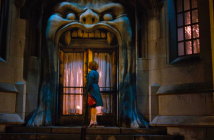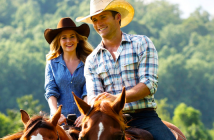
Blazing Saddles (1974)
Cast: Cleavon Little, Gene Wilder, Slim Pickens
Directors: Mel Brooks
Country: USA
Genre: Comedy
Editor’s Notes: The following review is part of our coverage for TIFF’s Mel Brooks: It’s Good to Be the King. For more information on upcoming TIFF film series visit http://tiff.net and follow TIFF on Twitter at @TIFF_NET.
Mel Brooks made 3 masterpieces in his career and they’re all right at the start. First there was The Producers, then Blazing Saddles and Young Frankenstein in the same year (!). The middle one is perhaps his most enduring (though the other two are far from forgotten) because of its brazen attitude. From the song in the opening credits, spoofing the iconic opening song from High Noon, we know that what we’re about to see is not going to be like anything we’ve ever seen before or since.
From the song in the opening credits, spoofing the iconic opening song from High Noon, we know that what we’re about to see is not going to be like anything we’ve ever seen before or since.
The story is really simple: corrupt Lt. Gov. Hedley Lemarr (Harvey Korman) (a gag that most people don’t get now, because he’s always referred to as Hedy Lemarr, a gorgeous actress who also co-invented the technology used for frequency hopping and spread spectrum communications that was the basis for today’s cell phone and wireless systems) needs to divert a railroad through a little frontier town called Rock Ridge, so he installs Bart (Cleavon Little), a black man who had worked on the railroad and was about to be hanged for striking his boss Taggart (Slim Pickins) in the head with a shovel. The town doesn’t take kindly to Bart but he eventually wins them over with the help of Jim, otherwise known as The Waco Kid (Gene Wilder) and also foils every attempt to defeat him concocted by Lemarr.

The story is more or less like an old B western, but infused with overt racial elements. The N-word flies freely from many mouths from the first scene onward. Some may be offended by this, but it’s done with purpose. It may be a bit excessive, but the point is to highlight and exaggerate the bigotry that was rampant in the post-Lincoln west that is not often remarked upon (except perhaps in Sergeant Rutledge) in the western genre. By putting everything out in the open, Brooks and his co-writers (one of whom was Richard Pryor, who was originally going to play Bart but the studio wouldn’t insure him) took every comical jab at racism and how stupid it really is without being heavy-handed about it. It’s confrontational even today but it works because it is confrontational. If it weren’t, it would be easy to dismiss it as not taking the subject seriously (which is a little ironic) or even belittling the real problem of bigotry in the U.S. at the time (not the 1860’s, the 1970’s).
What sets this, and his later film Young Frankenstein, apart from Brooks’ later works is that he used the tropes of the genera to make jokes on themselves and approached the genera with reverence instead of just parody. The difference between a spoof and a parody is in a spoof, the jokes are formatted around and born from the tropes and conventions whereas in parody the tropes and conventions are the jokes (that’s the last time I’ll use ‘tropes and conventions’, I promise). There is a tone of love and appreciation in this film that makes the jokes work better than if it had been approached with contempt.
At the core of the film is the relationship between Cleavon Little and Gene Wilder’s characters. The companionship between the two anchors the film and gives the audience a safe place to return to after Bart is verbally assaulted by the townsfolk or an attempt is made on his life. Jim is the only white person in the entire film that sees Bart as a person and doesn’t use the n-word. Without Bart, Jim would still be a drunk and without Jim, Bart would never have lasted in that town as sheriff.
Mel Brooks may not have known what he was creating when he was making Blazing Saddles and perhaps that’s a good thing. If he’d known it would have been as popular, he may not have gone whole hog and made the same movie.
Another thing that stands out is Brooks’ direction and his choices in lighting. He took the saturated look of the B western and applied it to the film despite making it in an era with more advanced film stock and better equipment. He seemed to want the entire film from look to feel to be a western from 20 years prior while giving it a plot and dialogue that could never have been made then (or now, really). As a director, Brooks has never really developed a style and his framing is often kind of sloppy, nor does he ever really get more than line readings from most of his actors but in an odd way that all works for his films. If they were meticulously crafted and well-acted, I don’t think they’d be as good. There are exceptions to the actor issue: Little, Wilder, Korman and a handful of others in other films, but his other cast members, himself included, go more for the joke and less for a performance. These touches let us know that they’re all in on the joke.
Add to that the meta quality of the film and the constant breaking of the fourth wall and this film changes the way comedies were made from that time onward. For better or for worse (often for worse) people saw this and tried to emulate it. From Brooks’ famous campfire farting scene came countless comedies where someone is taking a dump in a loud and horrible fashion (looking at you Dumb and Dumber and American Pie).
The film eventually grows so big that it can’t even contain itself. During the climactic battle of Rock Ridge, the camera pulls back, revealing the back lot the film is being shot on, turns and focuses on the Warner Bros. sound stages. Inside a Busby Berkley type musical number is being filmed when suddenly in bursts Blazing Saddles, still engaged in that fight sequence. It boils over to the commissary where Lemarr ducks out and tries to hide in a movie theater that is showing Blazing Saddles. The concept of being in a movie theater watching a movie that has a character coming into a movie theater and watching the same movie is layer upon layer of mind-boggling (it doesn’t have the same impact watching it at home). Then it finally reins itself in to finish up on another cliché, the heroes riding off together.
Mel Brooks may not have known what he was creating when he was making Blazing Saddles and perhaps that’s a good thing. If he’d known it would have been as popular, he may not have gone whole hog and made the same movie. Blazing Saddles stands as one of the best comedies ever made and is one of the most important films to come from arguably the best decade of American filmmaking. It set a high bar for comedy, one that is not often reached and never truly exceeded.
Blazing Saddles stands as one of the best comedies ever made and is one of the most important films to come from arguably the best decade of American filmmaking. It set a high bar for comedy, one that is not often reached and never truly exceeded.



